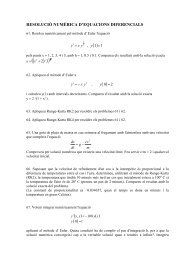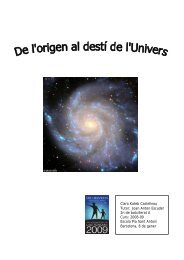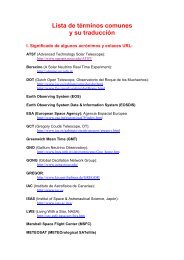Universitat de - Departament d'Astronomia i Meteorologia ...
Universitat de - Departament d'Astronomia i Meteorologia ...
Universitat de - Departament d'Astronomia i Meteorologia ...
You also want an ePaper? Increase the reach of your titles
YUMPU automatically turns print PDFs into web optimized ePapers that Google loves.
2.5. The optical/IR star: LS 5039 61<br />
Since no Hα emission was seen, the star could not fill its Roche lobe even at<br />
periastron, and consi<strong>de</strong>ring a radius of R = 10 R⊙ for an O7V star, they directly<br />
inferred a minimum mass of 15 M⊙ for the optical star, compatible with the expected<br />
mass of 36 M⊙. On the other hand, in or<strong>de</strong>r to avoid breakup speed of the star, the<br />
lowest inclination acceptable would be i 9 ◦ , and this would limit the maximum<br />
mass for the compact object to be MX 8 M⊙.<br />
We note that then it was unknown the improvement on the spectral type classifi-<br />
cation as an O6.5V((f)) star. However, the <strong>de</strong>rived values do not change significantly.<br />
In fact, consi<strong>de</strong>ring a mass of 40 M⊙ for an O6.5V((f)) star, as we have discussed<br />
in Sect. 2.5.3, we obtain a maximum mass for the compact object of 9 M⊙.<br />
Spectroscopic observations with the INT<br />
With the aim to confirm the results obtained by McSwain et al (2001), we have<br />
conducted new medium resolution spectroscopic observations of LS 5039 during 9<br />
consecutive nights. We have observed 17 LS 5039 using the Intermediate Dispersion<br />
Spectrograph (IDS) attached to the 2.5 m Isaac Newton Telescope (INT) 18 on the<br />
nights of 2002 July 23–31. A total of 96 spectra were obtained with the combination<br />
of the 235 mm camera and the R900V grating, which provi<strong>de</strong>d a useful wavelength<br />
coverage (free from vignetting) of λλ 3900–5500. The seeing was variable (1 ′′ –2 ′′ )<br />
during our run and we used a 1.2 ′′ slit which resulted in a resolution of 83 km s −1<br />
(FWHM). In addition, we also obtained five spectra of LS 5039 with the holografic<br />
grating H2400B for the purpose of measuring the rotational broa<strong>de</strong>ning (V sin i)<br />
of the companion’s absorption lines. The spectral resolution of these spectra was<br />
30 km s −1 and we varied the central wavelength in or<strong>de</strong>r to fully cover the range<br />
λλ 3900–5100, where most of the prominent He i and He ii lines lie. The spectral<br />
type standards HR 8622 (O9V spectral type) and HD 168075 (O7V((f)) spectral<br />
type) were also observed with the same instrumental configurations. A complete log<br />
of the observations is provi<strong>de</strong>d in Table 2.7.<br />
The images were <strong>de</strong>-biased and flat-fiel<strong>de</strong>d, and the spectra subsequently ex-<br />
tracted using conventional optimal extraction techniques in or<strong>de</strong>r to optimize the<br />
signal-to-noise ratio of the output (Horne 1986). CuAr and CuNe comparison lamp<br />
17 Casares, J., Ribó, M., Pare<strong>de</strong>s, J. M., & Martí, J. 2002, in preparation.<br />
18 The INT is operated on the island of La Palma by the Royal Greenwich Observatory in the<br />
Spanish Observatorio <strong>de</strong>l Roque <strong>de</strong> Los Muchachos of the Instituto <strong>de</strong> Astrofísica <strong>de</strong> Canarias.






